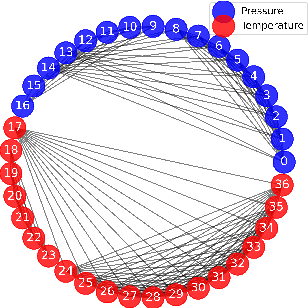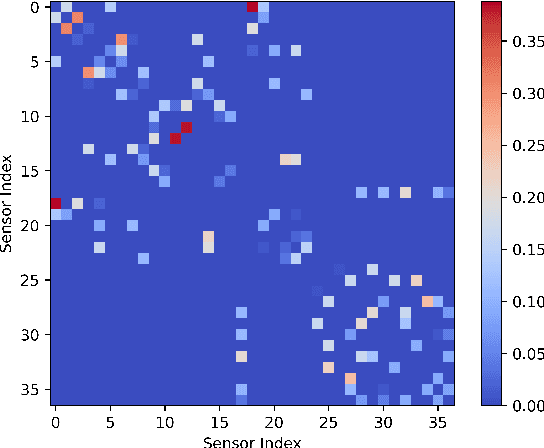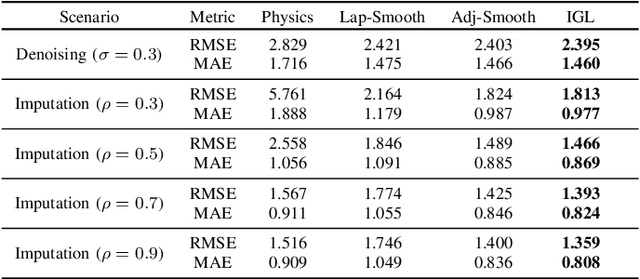Keivan Faghih Niresi
Efficient Unsupervised Domain Adaptation Regression for Spatial-Temporal Air Quality Sensor Fusion
Nov 11, 2024Abstract:The deployment of affordable Internet of Things (IoT) sensors for air pollution monitoring has increased in recent years due to their scalability and cost-effectiveness. However, accurately calibrating these sensors in uncontrolled environments remains a significant challenge. While expensive reference sensors can provide accurate ground truth data, they are often deployed on a limited scale due to high costs, leading to a scarcity of labeled data. In diverse urban environments, data distributions constantly shift due to varying factors such as traffic patterns, industrial activities, and weather conditions, which impact sensor readings. Consequently, traditional machine learning models -- despite their increasing deployment for environmental sensor calibration -- often struggle to provide reliable pollutant measurements across different locations due to domain shifts. To address these challenges, we propose a novel unsupervised domain adaptation (UDA) method specifically tailored for regression tasks on graph-structured data. Our approach leverages Graph Neural Networks (GNNs) to model the relationships between sensors. To effectively capture critical spatial-temporal interactions, we incorporate spatial-temporal graph neural networks (STGNNs), which extend GNNs by incorporating temporal dynamics. To handle the resulting larger embeddings, we propose a domain adaptation method using a closed-form solution inspired by the Tikhonov-regularized least-squares problem. This method leverages Cholesky decomposition and power iteration to align the subspaces between source and target domains. By aligning these subspaces, our approach allows low-cost IoT sensors to learn calibration parameters from expensive reference sensors. This facilitates reliable pollutant measurements in new locations without the need for additional costly equipment.
Informed Graph Learning By Domain Knowledge Injection and Smooth Graph Signal Representation
Jun 06, 2024


Abstract:Graph signal processing represents an important advancement in the field of data analysis, extending conventional signal processing methodologies to complex networks and thereby facilitating the exploration of informative patterns and structures across various domains. However, acquiring the underlying graphs for specific applications remains a challenging task. While graph inference based on smooth graph signal representation has become one of the state-of-the-art methods, these approaches usually overlook the unique properties of networks, which are generally derived from domain-specific knowledge. Overlooking this information could make the approaches less interpretable and less effective overall. In this study, we propose a new graph inference method that leverages available domain knowledge. The proposed methodology is evaluated on the task of denoising and imputing missing sensor data, utilizing graph signal reconstruction techniques. The results demonstrate that incorporating domain knowledge into the graph inference process can improve graph signal reconstruction in district heating networks. Our code is available at \href{https://github.com/Keiv4n/IGL}{github.com/Keiv4n/IGL}.
Physics-Enhanced Graph Neural Networks For Soft Sensing in Industrial Internet of Things
Apr 11, 2024Abstract:The Industrial Internet of Things (IIoT) is reshaping manufacturing, industrial processes, and infrastructure management. By fostering new levels of automation, efficiency, and predictive maintenance, IIoT is transforming traditional industries into intelligent, seamlessly interconnected ecosystems. However, achieving highly reliable IIoT can be hindered by factors such as the cost of installing large numbers of sensors, limitations in retrofitting existing systems with sensors, or harsh environmental conditions that may make sensor installation impractical. Soft (virtual) sensing leverages mathematical models to estimate variables from physical sensor data, offering a solution to these challenges. Data-driven and physics-based modeling are the two main methodologies widely used for soft sensing. The choice between these strategies depends on the complexity of the underlying system, with the data-driven approach often being preferred when the physics-based inference models are intricate and present challenges for state estimation. However, conventional deep learning models are typically hindered by their inability to explicitly represent the complex interactions among various sensors. To address this limitation, we adopt Graph Neural Networks (GNNs), renowned for their ability to effectively capture the complex relationships between sensor measurements. In this research, we propose physics-enhanced GNNs, which integrate principles of physics into graph-based methodologies. This is achieved by augmenting additional nodes in the input graph derived from the underlying characteristics of the physical processes. Our evaluation of the proposed methodology on the case study of district heating networks reveals significant improvements over purely data-driven GNNs, even in the presence of noise and parameter inaccuracies.
Spatial-Temporal Graph Attention Fuser for Calibration in IoT Air Pollution Monitoring Systems
Sep 08, 2023Abstract:The use of Internet of Things (IoT) sensors for air pollution monitoring has significantly increased, resulting in the deployment of low-cost sensors. Despite this advancement, accurately calibrating these sensors in uncontrolled environmental conditions remains a challenge. To address this, we propose a novel approach that leverages graph neural networks, specifically the graph attention network module, to enhance the calibration process by fusing data from sensor arrays. Through our experiments, we demonstrate the effectiveness of our approach in significantly improving the calibration accuracy of sensors in IoT air pollution monitoring platforms.
 Add to Chrome
Add to Chrome Add to Firefox
Add to Firefox Add to Edge
Add to Edge